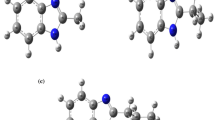Abstract
The effect of benzenethiol (BT) and some substituted benzenethiols — {o-methyl benzenethiol (o-MBT), o-amino benzenethiol (o-ABT), p-amino benzenethiol (p-ABT) and m-methyl benzenethiol (m-MBT)} — on the corrosion of copper in H2SO4 and NaOH solutions has been investigated by means of spectrophotometric measurements, potentiostatic polarization studies, cyclic voltammetry and potential stepping experiments. In acid solutions, under ordinary conditions, the thiols are adsorbed onto the metal surface in their molecular forms through their thiol(-SH) moiety and when the potential is made more noble oxidative dimerization of the thiols takes place, and the dimer replaces the thiol. Both thiols and their dimers are not effective as inhibitors. In alkaline solutionsin situ polymerization of thiol takes place to yield polythiol which is a very effective inhibitor both in acidic and alkaline media.
Similar content being viewed by others
References
N. Hackkerman,Bull. Electrochem. Soc. India 8 (1959) 9.
D. L. Riggs and R. L. Every,Corrosion 18 (1962) 262.
R. L. Le Roy,—ibid.34 (1978) 98.
M. S. Abdel Aal, A. A. Abdel Wahab and A. El Saiad,—ibid.37 (1981) 557.
A. Ronlan, in ‘Encyclopaedia of Electrochemistry of the elements,’ Vol. XI (edited by A. J. Bard and H. Lund) Marcel Dekker, New York (1978).
G. Mengoli,Adv. Polym. Sci 33 (1979) 26.
R. V. Subramaniam,—ibid.33 (1979) 43.
F. Bruno, M. V. Pham and J. E. Dibois,Electrochim. Acta 22 (1977) 451.
A. Ronlan and C. D. Parker,J. Chem. Soc. (C) (1971) 3214.
F. W. Steuber and K. Dimroth,Che. Ber. 99 (1966) 258.
N. Nickel, H. Mauser and U. Hezwl,Z. Phys. Chem. 154 (1967) 258.
C. Iwakura, M. Tsunaga and Hitamura,Electrochim. Acta 17 (1972) 1391.
K. Sasaki, S. Nanao and A. Kunai,Denki Dagadu Oyobi Kogyo Bussurri Dagadku 45 (1977) 130.
S. Daolio, G. Mengoli and M. M. Musiani,Electrochim. Acta 29 (1984) 1405.
B. G. Bravo, S. L. Michelhaugh, and M. P. Soriaga,J. Electrochem. 241 (1988) 453.
M. E. Mothwell, J. E. Rodriguez and M. P. S. Oriaga,J. Electroanal. Chem. 252 (1988) 453.
C. M. Friend, Symposium on Molecular phenomena at electrode surfaces 194th National Meeting of the American Chem. Soc., New Orleans, LA (1987).
J. G. N. Thomas, Symp. of Practical aspects of corrosion inhibition, Teddington, UK (1979). The Society of chemical Industry, London.
Author information
Authors and Affiliations
Rights and permissions
About this article
Cite this article
Sankarapapavinasam, S., Ahmed, M.F. Benzenethiols as inhibitors for the corrosion of copper. J Appl Electrochem 22, 390–395 (1992). https://doi.org/10.1007/BF01092694
Received:
Revised:
Issue Date:
DOI: https://doi.org/10.1007/BF01092694




